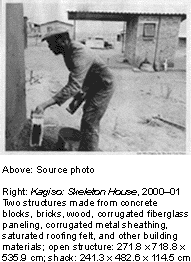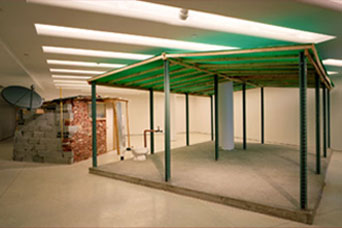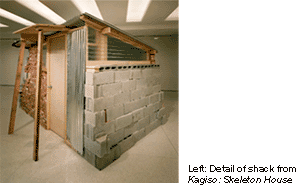|
Described as an urban
anthropologist, Marjetica Potrc, an artist and
trained architect, investigates the shifting
terrain of the contemporary city and its continual
reinvention. Potrc finds that the delight gleaned
from a visit to the ancient ruins of Pompeii can be
experienced in the contemplation of the empty lots
and abandoned buildings of today. For the artist,
these urban voids identify the city as a living
organism that expands and contracts in opposition
or relation to the regulated grid of the city.
Preoccupied with the dialogue between planned and
unplanned sections of the urban layout, Potrc
recognizes the growing number of disenfranchised
communities that have developed on the edges of
cities worldwide. The residents of these
shantytowns, favelas, or borgate, as they
are variously called, are among the world's
fastest-growing populations. Governmental efforts
to control these makeshift villages and absorb them
into organized social structures are often met with
resistance: The option of moving into anonymous
government housing projects is unappealing to many
individuals who regard their private dwellings as
more home than simply homemade. Potrc champions a
growing trend of what she terms "individual
initiatives"—ranging from squatter
cooperatives to private gated
communities—which have begun to threaten the
authority of corporate and government-managed
public space.
For this exhibition, Potrc has
installed Kagiso: Skeleton House, two
architectural structures that illustrate the
intersection between the regulated and unregulated
city. The larger of the two constructions is based
on a progressive, South African model of subsidized
housing in which a floor, roof, and rudimentary
plumbing system are supplied. Individual owners are
left with the fiscal and physical responsibility of
creating walls, doors, and interior spaces and thus
given the freedom to express their own unique
preferences and personalities. Next to this
skeleton house is a smaller shack cobbled together
from a mix of cast-off or easily acquired building
materials—a breed of "temporary" shelter seen
internationally. The skeleton house is meant to
replace the more humble dwelling, yet clearly
relies on it for inspiration. Kagiso: Skeleton
House, celebrates the nascent recognition of
the universal building style of the shanty by
regulatory bodies as a positive paradigm for viable
and affordable housing. With both of these
structures, the artist acknowledges a certain
beauty as well as an indomitable
resourcefulness.
Kagiso: Skeleton House, was
inspired by the story of a family who moved their
existing shack, piece by piece, to the site of
their unfinished skeleton house so that they could
be nearby to guard its toilet, a proven target of
theft. The unexpected value placed on this
fixture—for most a commonplace
necessity—is all the more pronounced when it
is seen beside the satellite dish attached to the
smaller structure. Potrc contends that the urge to
communicate and exchange information is as basic an
instinct as securing shelter and physical comfort.
It is the attempt to satisfy such simple human
needs that provokes the creativity that the artist
recognizes in these alternative housing situations
and equates with state-of-the-art inventions. The
proliferation of container buildings, mobile homes,
and recycled materials in Potrc's work is as much a
part of her vision of contemporary society as is
the wearable computer on view in this gallery. The
electronic garment is exhibited among a series of
poetic texts combined with appropriated images and
objects that comment on a range of contemporary
realities from the economic to the social. Together
these disparate snapshots and cultural artifacts
reflect responses to a global community made
smaller by technological advances and
interdependent economies. Mobility and
transformation characterize this world in which the
power of the nation-state has been relinquished to
the megacity, and public space has been abandoned
for the private realm of the individual.
|
 |



